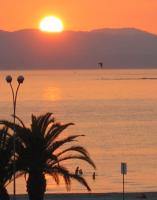


If you are looking for a place where nature is wonderful and varied, beautiful beaches, lush vegetation and fragrant, spectacular karst caves, etc.
...Alghero is the best place for you!
Town of over 40,000 people (in summer exceeding 100,000), Alghero is located in the north-west of Sardinia, in the province of Sassari, and is also famous as Riviera del Corallo, as it is one of the points where fishing the precious red coral, one of the most precious in the world.
Founded in 1102 by Doria, a powerful Genovese family, who exploited the strategic position of creating a more relevant and striking examples of military architecture of the island. He remained under their influence until 1353, when it came under the domination Catalan-Aragonese, which even today, after almost seven centuries, still possesses the characteristics urban architecture and language.
Fine examples of Catalan Gothic, including the church of San Francesco, with its characteristic stellar time in the presbytery and the evocative cloister. Even more surprising is the heritage language, the Catalan language is more alive than ever, as 40% of its residents speak the variation in Alghero.
Alghero is one of the few walled towns in Italy that has remained around 70% of its walls with adjoining towers: recently valued by a restoration, the bastions of Catalan-Aragonese era offer a very nice walk on the sea surrounding the city, and connecting with the Lungomare Dante (which brings up the road to Bosa) and with the recent Rambla (which leads to the beach).
The surrounding area is rich in sites of origin much more remote and historical importance, such as the complex of nuragic Palmavera and Sant'Imbenia. Right next to it, situated in the beautiful bay of Porto Conte, are still visible the remains of an ancient Roman villa. Other site of great interest, the largest of the burial complex in the region, is the necropolis Anghelu Ruju, located near the road of two seas - combining Alghero Porto Torres - and easily accessible from the airport.
The ancient city have an indescribable charm during the rites of Holy Week, due to the Catalan culture and the mysteries associated with the cult of the passion, the sacred drama of desclavament (down) and the Good Friday procession in the wooden statue of Christ, attract each years visitors from all over the world.
Alghero has a varied natural scenery, from sandy beaches to cliffs with jagged rocks or very flat. Especially the view from the sea captures the diversity of its coast, mixed with typical Mediterranean vegetation and pine forest that often surround; highly valued for its landscape is the promontory of Capo Caccia with its now famous cliff-shaped tortoise that became a symbol of Alghero, along with the precious coral.
The area of Capo Caccia, Isola Piana and facing the Gulf of Porto Conte is the primary site of natural interest, which recently was established Marine Protected Area.
The particular geological conformation makes the area rich in caves and ravines, still largely unexplored. Right here are the famous Caves of Neptune, is accessible by sea or by land (through the popular Escala Cabirol, of 656 steps), and it has got a wonderful view of rooms and pools, stalactites and stalagmites of particular forms.
Also in the protected area, you can go trekking: Noah's Ark is located in the area Tramariglio, here still nest on the edge of the cliffs the gryphon, and other protected birds such as peregrine falcon, the ghebbo, cormorants and gulls course, but you can also see examples of partridge, deer, horse and boar, as well as numerous protected plant species.
A few kilometers from Alghero, in the village of fertility, is a pond of brackish water (Calich), with the ruins of the Roman bridge, which once surged pink flamingos during the migration.
B&B Magralù Alghero - Via P. Paoli, 84 – 07041 Alghero (SS) - Tel. (0039) 079 986264 - e-mail: info@magralu-algherobb.com - COPYRIGHT©2008-2020